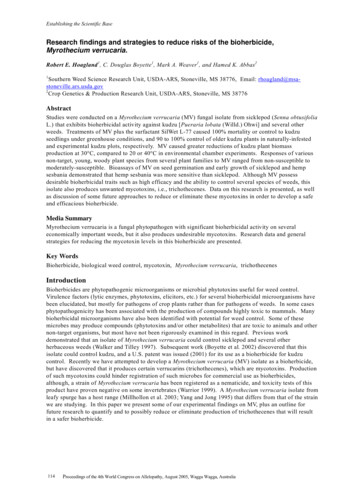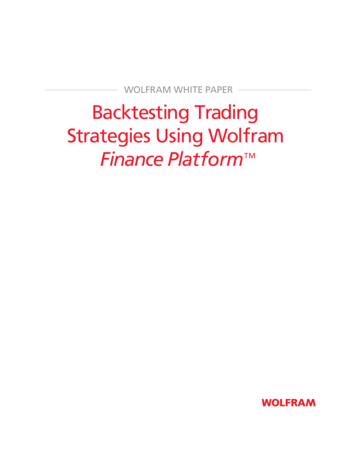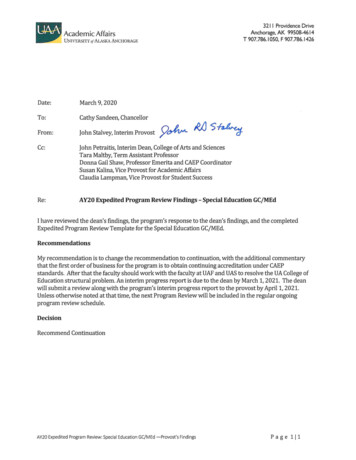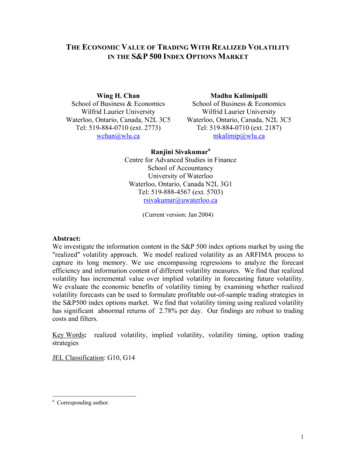
Transcription
Establishing the Scientific BaseResearch findings and strategies to reduce risks of the bioherbicide,Myrothecium verrucaria.Robert E. Hoagland 1, C. Douglas Boyette1, Mark A. Weaver1, and Hamed K. Abbas 21Southern Weed Science Research Unit, USDA-ARS, Stoneville, MS 38776, Email: rhoagland@msastoneville.ars.usda.gov2Crop Genetics & Production Research Unit, USDA-ARS, Stoneville, MS 38776AbstractStudies were conducted on a Myrothecium verrucaria (MV) fungal isolate from sicklepod (Senna obtusifoliaL.) that exhibits bioherbicidal activity against kudzu [Pueraria lobata (Willd.) Ohwi] and several otherweeds. Treatments of MV plus the surfactant SilWet L-77 caused 100% mortality or control to kudzuseedlings under greenhouse conditions, and 90 to 100% control of older kudzu plants in naturally-infestedand experimental kudzu plots, respectively. MV caused greater reductions of kudzu plant biomassproduction at 30 C, compared to 20 or 40 C in environmental chamber experiments. Responses of variousnon-target, young, woody plant species from several plant families to MV ranged from non-susceptible tomoderately-susceptible. Bioassays of MV on seed germination and early growth of sicklepod and hempsesbania demonstrated that hemp sesbania was more sensitive than sicklepod. Although MV possessdesirable bioherbicidal traits such as high efficacy and the ability to control several species of weeds, thisisolate also produces unwanted mycotoxins, i.e., trichothecenes. Data on this research is presented, as wellas discussion of some future approaches to reduce or eliminate these mycotoxins in order to develop a safeand efficacious bioherbicide.Media SummaryMyrothecium verrucaria is a fungal phytopathogen with significant bioherbicidal activity on severaleconomically important weeds, but it also produces undesirable mycotoxins. Research data and generalstrategies for reducing the mycotoxin levels in this bioherbicide are presented.Key WordsBioherbicide, biological weed control, mycotoxin, Myrothecium verrucaria, trichothecenesIntroductionBioherbicides are phytopathogenic microorganisms or microbial phytotoxins useful for weed control.Virulence factors (lytic enzymes, phytotoxins, elicitors, etc.) for several bioherbicidal microorganisms havebeen elucidated, but mostly for pathogens of crop plants rather than for pathogens of weeds. In some casesphytopathogenicity has been associated with the production of compounds highly toxic to mammals. Manybioherbicidal microorganisms have also been identified with potential for weed control. Some of thesemicrobes may produce compounds (phytotoxins and/or other metabolites) that are toxic to animals and othernon-target organisms, but most have not been rigorously examined in this regard. Previous workdemonstrated that an isolate of Myrothecium verrucaria could control sicklepod and several otherherbaceous weeds (Walker and Tilley 1997). Subsequent work (Boyette et al. 2002) discovered that thisisolate could control kudzu, and a U.S. patent was issued (2001) for its use as a bioherbicide for kudzucontrol. Recently we have attempted to develop a Myrothecium verrucaria (MV) isolate as a bioherbicide,but have discovered that it produces certain verrucarins (trichothecenes), which are mycotoxins. Productionof such mycotoxins could hinder registration of such microbes for commercial use as bioherbicides,although, a strain of Myrothecium verrucaria has been registered as a nematicide, and toxicity tests of thisproduct have proven negative on some invertebrates (Warrior 1999). A Myrothecium verrucaria isolate fromleafy spurge has a host range (Millhollon et al. 2003; Yang and Jong 1995) that differs from that of the strainwe are studying. In this paper we present some of our experimental findings on MV, plus an outline forfuture research to quantify and to possibly reduce or eliminate production of trichothecenes that will resultin a safer bioherbicide.114Proceedings of the 4th World Congress on Allelopathy, August 2005, Wagga Wagga, Australia
Establishing the Scientific BaseMaterials and MethodsChemicals.Potato dextrose agar (PDA) was purchased from Difco Laboratories, Inc., Detroit, MI. SilWet L-77 wasobtained from Lovelace Industries, Greely, CO. All other chemicals used were of reagent grade purity orhigher.Myrothecium verrucaria Source and Culture.Cultures were obtained from H.L. Walker, Lousiana Tech University, Ruston, LA. Conidial preparations ofMV were produced in petri dishes containing Difco potato dextrose agar (PDA). Agar surfaces were floodedwith 3 mL of a MV conidia suspension (2 x 10 6 conidia per mL). Plates were then inverted on open-meshwire shelves and incubated (28 C, 5 da) in fluorescently lighted incubators. Conidia were rinsed from plateswith sterile distilled H2O, and adjusted with distilled H2O to desired concentrations (estimated withhemacytometer).Kudzu Propagation.Kudzu seedlings were grown from seed in pots containing a 1:1 commercial potting mix/soil combinationsupplemented with 13:13:13 (N:P:K) fertilizer under greenhouse conditions [28 to 32 C; 40 to 60% relativehumidity; 14 h photoperiod (1600 to 1800 µmol m-2s -1 PAR at midday)]. Hemp sesbania and sicklepodseedlings were grown hydroponically in paper towel cylinders (Hoagland 1995).Kudzu Treatments.Kudzu plants (2 to 4 leaf growth stage) were sprayed (hand-held compressed air sprayer) with inoculum (2 x10 7 conidia per ml) until the foliage was wet ( 500 L ha-1). Silwet L-77 surfactant at 0.2% was used in alltreatments, and control plants received 0.2% surfactant only. Experimental units consisted of 10 plants eachand treatments were replicated three times. After inoculation, plants were placed in growth chambers atconstant day/night temperatures of 20, 30, or 40 C, 12 h day/12 h night, at 900 µmol m-2s -1 PAR. Diseasedevelopment was monitored daily, and at 14 days after inoculation, both living and dead plants were excisedat the soil surface, and dried (80 C, 7 da) for dry-weight determinations. A randomized complete blockexperimental design was utilized and means were separated using Fisher’s Least Significant Difference at p 0.05.Host Range and Field Efficacy Tests.Naturally forested areas. Two areas were selected in June 1999 near Yazoo City and Greenwood, MS toexamine the effects of MV on various woody plant species in the field. Ten individual plants of eachspecies (see Table1) were sprayed with MV (2.0 x 10 7 conidia per mL at 300 L per ha) in 0.2 % Silwet L-77surfactant, or with surfactant alone. Plots (3 m x 3 m) were established in adjacent areas that were heavilyinfested with kudzu. These treatments were also applied to the kudzu in triplicate plots. Symptomologicaleffects on kudzu were monitored for up to 6 weeks, and the trees were monitored on each site until late fall.A visual rating scale where: ns not susceptible (no visual sympomatology), ss slightly susceptible (leafspotting and/or chlorosis), ms moderately susceptible (leaf spots/leaf abscission at 30 to 50 %), andhs highly susceptible (severe leaf spotting/abscission at 50 %) was utilized for the woody plants andtrees. Kudzu control was determined visually as percentage control as compared to surfactant–treatedplants.Experimentally planted areas. Several species of oak (Quercus) trees were obtained from USDA SouthernHardwoods Forestry Research Station, Stoneville, MS and transplanted in plots in June 1999, at the SWSRUResearch Farm, Stoneville, MS. Three kudzu seedlings (ca. 30 cm tall) were transplanted at the base of eachtree. After acclimation (ca. 7 days) five trees of each species and the corresponding kudzu plants weresprayed with MV conidia (2 x 10 7 per mL) in Silwet L-77 (0.20 %, v/v), or with surfactant alone using abackpack sprayer at a rate of about 300 L per ha. Evaluations were made weekly over a 3-week interval.Plant BioassaysSeedling tests. Seeds of sicklepod and hemp sesbania were obtained from field plots at the SWSRUResearch Farm, Stoneville, MS. Seeds were mechanically scarified, planted between moistened papertowels, rolled into cylinders, and grown hydroponically (Hoagland 1995) in the dark in an environmentalchamber (28 C). After 4 days dark growth, uniform seedlings were selected, their shoot lengths measuredProceedings of the 4th World Congress on Allelopathy, August 2005, Wagga Wagga, Australia115
Establishing the Scientific Baseand they were placed into paper towel cylinders (5 to 8 seedlings per cylinder). Seedlings were thensprayed in triplicate with water (control), or MV conidia at several concentrations, using a hand-heldcompressed air sprayer. The treated seedlings were incubated at 28 C in the dark, and shoot elongation wasdetermined at 48 and 72 h after treatment (HAT).Seed germination and early growth tests. Sicklepod and hemp sesbania were obtained as described above.Three replicates of twenty seeds of each species were placed in wells of a 24- well-plate. Then 750:lwater:SilWet, or MV conidia at several concentrations (5 x 104 to 10 8 conidia per ml) with and withoutSilWet were added to each well. After 14 h imbibition during incubation in an environmental chamber(28 C) in the dark, the seeds were removed from each well with forceps and placed into plastic Petri dishes(60 x 15 mm) containing one filter paper disk. An additional aliquot (500 µl) of each treatment solution wasadded, the plates were covered, followed by incubation under the conditions described above. Seedgermination and early seedling growth were recorded at several intervals (germination, 14 to 48 HAT), andgrowth measurements [seedling elongation (mm), 14 to 72 HAT] over a 72-h time course.Table 1. Response of various woody plant species to Myrothecium verrucaria.FAMILYScientific nameANACARDIACEAERhus toxicodendron L.CUPRESSACEAEJuniperus virginiana L.FAGACEAEQuercus alba L.Q. stellata Waugh.Q. falcata Michx.Q. nigra LQ. nuttallii PalmerQ. palustris Muench.Q. velutina Lam.HAMAMELIDACEAELiquidamber styraciflua L.JUGLANDACEAECarya aquatica (Michx. F.) Nutt.C. illinoisensis (Wang.) K. KochCommon nameDisease Response1Poison ivymsEastern red cedarnsWhite oakPost oakSouthern red oakWater oakNuttall oakPin oakBlack oakssssnsnsnsnsnsSweetgummsWater hickoryssPecanssLAURACEAESassafras albidum (Nutt.) NeesSassafrassmsLILIACEAESmilax bona-nox L.CatbriarmsPINACEAEPinus echinata Mill.Shortleaf pinessP. palustris Mill.Longleaf pinessP. taeda L.Loblolly pinessP. virginiana L.Virginia pinessPLATANACEAEPlatanus occidentalis L.American sycamore nsROSACEAERubus sp.BlackberrymsSALICACEAEPopulus deltoides Marsh.CottonwoodssULMACEAECeltis laevigata Willd.Southern hackberry ms1Visual rating scale: ns not susceptible (no visual symptomatology), ss slightly susceptible (leafspotting and/or chlorosis), ms moderately susceptible (leaf spots/leaf abscission at 30 to 50 %), and hs highly susceptible (severe leaf spotting/abscission at 50 %).116Proceedings of the 4th World Congress on Allelopathy, August 2005, Wagga Wagga, Australia
Establishing the Scientific BaseResults and DiscussionHost range woody spp.MV host range tests on various woody plants expected to occur in kudzu habit areas showed that over 70%of these species were not sensitive, or only slightly sensitive to MV applications (Table1). Several specieswere moderately sensitive, but these plants recovered from the initial injury several weeks after application.None of the test plants exhibited mortality, or effects greater than moderately susceptible, even after fungalapplications over two seasons. Original host–range tests with this isolate on a variety of mono- anddicotyledenous plants showed mortality levels 85% for: radish, beet, chenopodium, English pea,sicklepod, hemp sesbania, and jimsonweed (Walker and Tilley 1997). Also many other species exhibitedsevere reductions in dry-weight accumulation, indicating broad-spectrum bioherbicidal activity. Out of 14monocots tested, none exhibited mortality, and dry-weight reductions were low (Walker and Tilley 1997).Other studies of host range on a similar set of plants generally supported these findings (Anderson andHallet 2004). A different isolate of Myrothecium verrucaria from leafy spurge (Euphorbia esula L.) possessa different host range on several weeds (Millhollon et al. 2003; Yang and Jong 1995).Evaluations of kudzu control in naturally- and experimentally-infested field sites using spray applications ofMV plus SilWet surfactant indicated 100 % control in the experimental plots containing transplantedseedlings, which was slightly higher than control obtained in the naturally-infested sites (Table 2). Thesurfactant alone caused no damage to kudzu in either of the treated plot areas.Table 2. Biological control of kudzu in naturally- and experimentally-infested field sitesTreatmentKudzu control (%) aNaturally infestedMV SilWet88SilWet alone0Untreated0aValues are means of three replicates.Experimentally infested10000Some isolates of MV are pathogenic to several ornamental and crop plants (Cunfer et al. 1969; Leath andKendall 1983; Nguyen et al. 1973). Virulence and host range differences of MV isolates have also beennoted (Cunfer et al. 1969; Nguyen et al. 1973; Yang and Jong 1995a). Other MV isolates have bioherbicidalactivity on control thistle (Carduus acanthoides L.) and leafy spurge (Euphorbia esula L.)(Yang and Jong1995a,b)Kudzu tests. Kudzu was sensitive to MV when greenhouse plants (2 to 4 leaf stage) were sprayed withconidia preparations and evaluated after 5 days (Figure 1). We have also found a temperature-injuryinteraction of this bioherbicide on kudzu (Figure 2). Dry weight reduction in fungus-treated kudzu plantswas only 40% at 20 C, but was elevated to 92 and 85% at 30 C and 40 C, respectively. This is a usefulfinding, since kudzu breaks dormancy and thrives during warm weather conditions.Figure 1. Effect of MV on kudzu seedlings grown under greenhouse conditions. A untreated plants; B plantstreated with MV (1x10 8 conidia mL -1 ) plus 0.2% SilWet L-77. Three days after treatment.Proceedings of the 4th World Congress on Allelopathy, August 2005, Wagga Wagga, Australia117
Establishing the Scientific BaseFigure 2. Effect of temperature on growth reduction of kudzu seedlings by MV conidia.Plant and seed bioassay tests. Seedling growth and mortality bioassays have been developed to evaluatebioherbicidal efficacy on sicklepod and hemp sesbania (Hoagland 1995). This bioassay system was alsoused to examine MV effects on young seedlings of these two species (Table 3). Seedling growth of bothspecies was affected by relatively high conidia levels and after 24 h hemp sesbania shoot elongation wasreduced by 85%, compared to 52% reduction in sicklepod. Both species were also sensitive to lower conidiaconcentrations, i.e., 106 and 107, and hemp sesbania growth was reduced to a greater degree (data notshown). The greater sensitivity of hemp sesbania versus sicklepod agrees with data on older plants (Walkerand Tilley 1997; Anderson and Hallet 2004). This suggests the utility of this whole plant seedling bioassayfor relatively rapid testing of MV, isolates and /or manipulated strains.Table 3. Growth bioassays of M. verrucaria on hydroponically-grown weed seedlings.Shoot elongationTreatment48 h96 hH2033.5a47.2aMV (10 8 spores / ml)5.2v7.8bMV (3.5 x 108 spores / ml)2.8c3.4cSicklepodH2019.7a33.0aMV (10 8 spores / ml)9.5b16.2b8MV (3.5 x 10 spores / ml)4.2c7.6cValues are means of three replicates. Values followed by different letters within a column and species aresignificantly different (p 0.05)SpeciesHemp sesbaniaWe also examined the effects of MV on seeds of these sensitive weeds. Seed germination was altered atsome conidial concentrations (Figure 3). Furthermore, early growth of these two species was affected atseveral conidial concentrations (Figure 4). In these tests, the higher sensitivity of hemp sesbania versussicklepod to this fungus was again demonstrated. In similar tests with kudzu seeds, germination and earlygrowth was also drastically inhibited by MV conidia applied at similar concentrations (data not shown).Overall, results suggest that this bioherbicide might also reduce weed seed viability on mature plants, andpossibly in seed banks at or near soil surfaces where the bioherbicide is applied.Work by others on this isolate also indicates that cell-free culture filtrates contain phytotoxins (Walker andTilley 1997; Anderson and Hallet 2004). Also in host range tests, many broadleaf species were sensitive tocrude MV spray applications, but generally monocots were more tolerant.118Proceedings of the 4th World Congress on Allelopathy, August 2005, Wagga Wagga, Australia
Establishing the Scientific BaseFigure 3. Seed germination of two weeds (SIC sicklepod; H.S. hemp sesbania) as affected by variousconidial concentrations of MV. SIL SilWet L-77control.Figure 4. Seedling growth of seeds of two weeds (SIC sicklepod; H.S. hemp sesbania) imbibed in variousconidial concentrations of MV. SIL SilWet L-77control.Future Research Approaches for Safe and Effective Use of Myrothecium verrucariaCultural methods to reduce trichothecene productionNumerous conditions are known to influence the timing and amount of secondary metabolite production byfungi in culture. Altered levels of free moisture and osmotic potential (Schrodter 2004; Garrett et al. 1998;Ren et al. 1999), carbon and nitrogen levels (Abdollahi and Buchanan 1981; Kacholz and Demain 1983;Buchanan and Stahl 1984; Feng and Leonard 1998; Costa et al. 2004), temperature (Diener and Davis 1966)and pH (Jarvis 1971; Ehrlich and Cotty 2003; Keller et al. 1997) are determinants of mycotoxin productionin other systems. Cultural regulation of trichothecene biosynthesis in MV is not as well studied, but similarmanipulations may enable production of the bioherbicide without the risk associated with trichothecenes.We will systematically examine many of these parameters to determine their effects on trichotheceneproduction in MV.Chemical inhibitors to lower trichothecene productionTrichothecene synthesis is initiated from farnesyl pyrophosphate produced by farnesyl pyrophosphatesynthetase (FPPS). Although many of these associated genes have been identified, few enzymes, (e.g.,trichodiene synthetase (TS), and certain cytochrome P450s) have been implicated in key roles in thispathway (Trapp et al. 1998; Tag et al. 2001; Peplow et al. 2003). Various chemicals may inhibit these andother enzymes of the trichothecene pathway. Several pharmaceutical drugs are inhibitors of FPPS, i.e.,nitrogen-containing bisphosphonates (zoledronic acid, minodronate, etc.) (Dunford et al. 2001), and othercompounds (e.g., 1-aminoenzotriazol, piperonyl butoxide, and tetcyclasis) can inhibit cytochrome P450s.Since mevalonate is important to the pathway, mevinolin (HMG-CoA reductase inhibitor) may also altertrichothecene synthesis (Petras et al. 1999). Synthetic acid amides have been suggested to be inhibitors ofP450 monooxygenases and the natural compound narengenin is also a P450 inhibitor. Cultures of MV willbe exposed to potential inhibitors at various concentrations. Then, radial growth rates of MV will bemeasured and cultures will be assessed for trichothecene deficiency using methodology such as a Chlorellavulgaris bioassay (Bean et al. 1992) and/or ELISA. Trichothecene inhibitors identified in such assays, thatdo not reduce MV growth, will be examined for effects on the total trichothecene profile using HPLC(Abbas et al. 2001).Selection of trichothecene deficient MV strainsGenetic and biochemical pathways leading to trichothecene production have been partially characterized inother systems (Brown et al. 2001; Kimura et al. 2003). Secondary metabolism is known to be unstable insome fungi (Bennett and Papa 1988; Horn and Doner 2001). For example, efficient commercial productionof penicillin (another fungal secondary metabolite), has been made possible by numerous selections ofisolates over many generations with different levels of antibiotic production (Peñalva et al. 1998). We haveobserved sector formation in MV, and noted variable levels of trichothecene production from these sectorsof the same parent strain (Hoagland et al. 2005). Recurrent selection of these sectors, chemical mutagenesis,and site-directed mutagenesis may lead to further reduction or elimination of trichothecene production. TheProceedings of the 4th World Congress on Allelopathy, August 2005, Wagga Wagga, Australia119
Establishing the Scientific Baserole of trichothecenes as virulence factors on target weed species is unclear, but development of effectiveMV bioherbicidal strains with minimized toxicological properties may be possible.Post-release environmental monitoringIn addition to human health risks from exposure to MV mycotoxins, environmental risks must also beconsidered. Host-range tests have not identified likely adverse effects on many non-target, desirable plantspecies, but we will monitor for spread this fungus to nearby crops and weeds. We also plan to monitor theeffects of MV deployment on indigenous microflora of target weeds and associated crops though culturalindependent whole-community profiling [e.g., fatty acid methyl ester (FAME) and 16S terminal restrictionfragment length polymorphism (T-RFLP)]. Currently, insufficient information restricts meaningfulpredictions of the long-term environmental fate of MV, especially when applied augmentatively. To bridgethis gap, real-time polymerase chain reaction (RT-PCR) to quantitatively monitor the deployed strain in soiland plant surfaces will be useful.MV Risk; Constraints of product useGreenhouse studies showed that foliar application of MV to soybean plants caused dry weight reductions ofup to 75%. However, when MV was applied as a directed spray to lower stems and leaves in mixedplantings of soybean and sicklepod, soybean dry weights were not affected and sicklepod seedling mortalitywas 97% (Walker and Tilley 1997). Thus risks to crops may in some cases, be avoided or minimized bydirected spray application of a bioherbicide.Summary and ConclusionsOverall bioherbicides offer promising alternatives to synthetic herbicides for some applications andsituations. The role of bioherbicides may be more suited to niche markets and situations where syntheticherbicides are not registered or are not developed. Bioherbicides may be used as complimentarycomponents in successful integrated management strategies and for the discovery of new chemical classes ofphytotoxins with novel modes of action. As with synthetic herbicides, there is concern of host (weed)resistance developing if a bioherbicide is used repeatedly. This is part of the risk associated with chemicalor biological weed control methods. Questions regarding non-target hosts of bioherbicidal pathogens can begenerally answered by extensive host range studies, however such testing is not fail-safe. There are otherparallels of synthetic and biological herbicides. During developmental stages, both must be handled withminimum exposure to researchers and the environment. Another important issue in cases where aphytopathogen may produce a mycotoxin, is the determination of the active principle, and whether thephytotoxin is identical or related to the mycotoxin. As evidenced from this account, plant pathogens maycontain compounds that are harmful to human health. Knowledge of the nature and regulation of productionof toxic secondary compounds, and the safe handling of these agents can substantially lower or eliminateany possible health-associated risks.ReferencesAbbas HK, Tak H, Boyette CD, Shier WT, Jarvis BB (2001). Macrocyclic trichothecenes are undetectable in kudzu(Pueraria montana) plants treated with a high-producing isolate of Myrothecium verrucaria. Phytochemistry 58,269-276.Abdollahi A, Buchanan RL (1981). Regulation of aflatoxin biosynthesis: induction of aflatoxin production by variouscarbohydrates. Journal of Food Science 46, 633-635.Anderson KI, Hallet SG (2004). Herbicidal spectrum and activity of Myrothecium verrucaria. Weed Science 52, 623627.Bean GA, Jarvis BB, Aboul-Nasr MB (1992). A biological assay for the detection of Myrothecium spp. producedmacrocyclic trichothecenes. Mycopathologia 119, 175-180.Bennett JW, Papa KE (1988). The aflatoxigenic Aspergillus spp. In ‘Genetics of Plant Pathogenic Fungi’. pp. 263-278.(Academic Press: London).Boyette CD, Walker HL, Abbas HK (2002). Biological control of kudzu (Pueraria lobata) with an isolate ofMyrothecium verrucaria. Biocontrol Science and Technology 12, 75-82.Brown DW, McCormick SP, Alexander NJ, Proctor RH, Desjardins AE (2001). A genetic and biochemical approach tostudy trichothecene diversity in Fusarium sporotrichioides and F. graminearum. Fungal Genetics and Biology 32,121-133.Buchanan RL, Stahl HG (1984). Ability of various carbon sources to induce and support aflatoxin synthesis byAspergillus parasiticus. Journal of Food Safety 6, 271-279.120Proceedings of the 4th World Congress on Allelopathy, August 2005, Wagga Wagga, Australia
Establishing the Scientific BaseCosta JM, Corbellini VA, Scroferneker ML (2004). Study of different nitrogen sources on glucose uptake andproduction of melanin precursors and fungal mass of Fonsecaea pedrosoi culture in tricyclazole. ProcessBiochemistry 39, 633-636Cunfer BM, Graham JH, Lukezic FL (1969). Studies on the biology of Myrothecium roridum and M. verrucariapathogenic on red clover. Phytopathology 59, 1306-1309.Diener UL, Davis ND (1966). Aflatoxin production by isolates of Aspergillus flavus. Phytopathology 56, 1390-1393.Dunford JE, Thompson K, Coxon FP, Luckman SP, Hahn FM, Poulter CD, Ebetino FH, Rogers MJ (2001). Structureactivity relationships for inhibition of farnesyl diphosphate synthase in vitro and inhibition of bone resorption invivo by nitrogen-containing bisphosphonates. Pharmacology 296, 235-242.Ehrlich K, Cotty PJ (2003). Aflatoxin control through targeting mechanisms governing aflatoxin biosynthesis in crops.XXII Fungal Genetics Conference Proceedings Abstr. No. 201, p 283.Feng GH, Leonard TJ (1998). Culture conditions control expression of the genes for aflatoxin and sterigmatocystinbiosynthesis in Aspergillus parasiticus and A. nidulans. Appied and Environmental Microbiology 64, 2275-2277.Garrett MH, Rayment PR, Hooper MA, Abramson MJ, Hooper BM (1998). Indoor airborne fungal spores, housedampness and associations with environmental factors and respiratory health in children. Clinical andExperimental Allergy 28, 459-467.Hoagland RE (1995). Hydroponic seedling bioassay for the bioherbicides Colletotrichum truncatum and Alternariacassiae. Biocontrol Science and Technology 5, 251-259.Hoagland RE, Weaver MA, Boyette CD (2005). ELISA detection of trichothecenes in the bioherbicide Myrotheciumverrucaria. Proceedings of the Weed Science Society of America 45, No. 213.Horn B, Dorner JW (2001). Effect of competition and adverse culture conditions on aflatoxin production by Aspergillusflavus through successive generations. Mycologia 94, 741-751.Jarvis B (1971). Factors affecting the production of mycotoxins. Journal of Applied Bacteriology 34, 199-213.Kacholz T, Demain AL (1983). Nitrate repression of averufin and aflatoxin biosynthesis. Journal of Natural Products46, 499-506.Keller NP, Nesbitt C, Sarr B, Phillips TD, Burow GB (1997). pH regulation of sterigmatocystin and aflatoxinbiosynthesis in Aspergillus spp. Phytopathology 87, 643-648.Kimura M, Tokai T, O’Donnell K, Ward T J, Fujimura M, Hamamoto H, Shibata T, Yamaguchi I (2003). Thetrichothecene biosynthesis gene cluster of Fusarium graminearum F15 contains a limited number of essentialpathway genes and expressed non-essential genes. Federation of European Biochemical Societies Letters 539, 105110.Leath KT, Kendall WA (1983). Root rot alfalfa and red clover caused by Myrothecium spp. Plant Disease 67, 11541155.Millhollon RW, Berner DK, Paxson LK, Jarvis BB, Bean GW. (2003). Myrothecium verrucaria for control of annualmorningglories in sugarcane. Weed Technology 17, 276-283.Nguyen TH, Mathur SB, Neergaard P (1973). Seed--borne species of Myrothecium and their pathogenic potential.Transactions of the British Mycological Society 61, 347-354.Peñalva MA, Rowlands RT, Turner G (1998). The optimization of penicillin biosynthesis in fungi. Trends ofBiotechnology 16, 483-489.Peplow AW, Tag AG, Garifullina GF, Beremand MN (2003). Identification of new genes positively regulated by Tri10and a regulatory network for trichothecene mycotoxin production. Applied and Environmental Microbiology 69,2731-2736.Petras SF, Lindsey S, Harwood JH, Jr. (1999). HMG-CoA reductase regulation: use of structurally diverse first halfreaction squalene synthetase inhibitors to characterize the site of mevalonate-derived non-sterol regulatorproduction in cultured IM-9 cells. Journal of Lipid Research 40, 24-38.Ren P, Ahearn DG, Crow SA (1999). Comparative study of Aspergillus mycotoxin production on enriched media andconstruction material. Journal of Industrial Microbiology and Biotechnology. 23, 209-213.Schrodter R (2004). Influence of harvest and storage conditions on trichothecene levels in various cereals. ToxicologyLetters 153, 47-49.Tag AG, Garifullina GF, Peplow AW, Ake C, Jr., Philips TD, Hohn TM, Beremand MN (2001). A novel regulatorygene, Tri10 controls trichothecene toxin production and gene expression. Applied Environmental Microbiology 67,5294-5302.Trapp SC, Hohm TM, McCormick S, Jarvis BB (1998). Characterization of the gene cluster for biosynthesis ofmacrocyclic trichothecenes in Myrothecium roridum. Molecular and General Genetics 257, 421-432.Walker HL, Tilley AM (1997). Evaluation of an isolate of Myrothecium verrucaria from sicklepod (Senna obtusifolia)as a potential mycoherbicide agent. Biological Control 10, 104-112.Warrior P, Rehberger LA, Beacu M, Grau PA, Kirfman GW, Conley JM (1999). Commercial development andintroduction of DiTeraTM, a new nematicide. Pesti
Poison ivy ms CUPRESSACEAE Juniperus virginiana L. Eastern red cedar ns FAGACEAE Quercus alba L. White oak ss Q. stellata Waugh. Post oak ss Q. falcata Michx. Southern red oak ns Q. nigra L Water oak ns Q. nuttallii Palmer Nuttall oak ns Q. palustris Muench. Pin oak ns Q. velutina Lam. Black oak ns HAMAMELIDACEAE Liquidamber styraciflua L.











